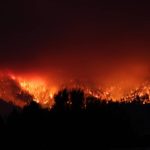Manage forests, or watch them burn
Posted: October 2, 2017Source: Capital Press

For those who had not witnessed the blast-furnace heat and the eye-stinging smoke of a wildfire along with the mass destruction of timber, homes, businesses and wildlife, last week was a learning experience.
Nearly every corner of the West was on fire. From Arizona to Washington state and from California to Montana, 65 active fires were burning 2.83 million acres as of late last week. Those numbers include only the fires that were 10,000 acres or larger. The average size of those fires was 43,556 acres.
In some areas, including Portland and Los Angeles, the fires got too close for comfort. Drivers on Los Angeles expressways could see flames racing up the hillsides, and Interstate 84 east of Portland was closed as firefighters valiantly worked to keep the wind-driven flames at bay.
For many Western city dwellers, wildfires just got personal. They were no longer something they watched from afar, viewing video snippets from the safety of their homes and apartments. The stench of smoke could be smelled and the raging flames could be seen up close.
Firefighters were forced to prioritize which blazes to fight and which to let go. They hoped to save the lodge at Multnomah Falls in the Columbia Gorge and the lodge at McDonald Lake in Glacier National Park. They battled to keep fires away from Yosemite and Yellowstone national parks.
Among politicians, the chatter was about how to fund firefighters — talk about fiddling while the West burns. They want to make sure the money for fireighters doesn’t come out of the U.S. Forest Service budget but from the money set aside for disasters.
This chatter has been going on for years now, and any effective member of Congress would have gotten it passed and signed by the president. But we haven’t really seen much in the way of effectiveness coming out of Congress recently, have we?
What they need to talk about — and take action on — is the absolutely irresponsible and short-sighted way public lands in the West are managed.
Let’s start with forests.
At some point the Obama administration decided nearly all federal forests were off-limits to logging, the best and only way to manage forests. For years, foresters have been warning that letting forests go unmanaged will only mean bigger and badder wildfires in the future.
We need federal managers who are allowed to effectively manage publicly owned forests. Instead of taking out roads from national forests, they need to leave them in place. They need to sell timber in strategic ways that will make fighting the next wildfires easier.
In the vast open spaces of the West they need to allow more cattle grazing, which has been shown to be an effective way to keep down cheatgrass and other weeds that burn hot and kill the ecosystem. Juniper trees need to be taken out of all areas, including wilderness, where they are destroying the countryside and hindering the recovery of the greater sage grouse and other important species.
The people who know the West best are those who live there. Federal managers need to listen when people tell them that they are setting up the region for disastrous fires. That has happened time and time again, especially in Oregon and Washington state.
And don’t listen to critics who holler that people just want to clearcut the West. In decades past, federal land was actively managed — logged — and the forests are still a beautiful resource. Those who say they don’t want one tree cut down are simply denying the fact that forests need to be managed, or they will eventually be destroyed by wildfire, bark beetles or disease.
Managing forests and open spaces will not put an end to wildfires, but it will reduce their size and number.

